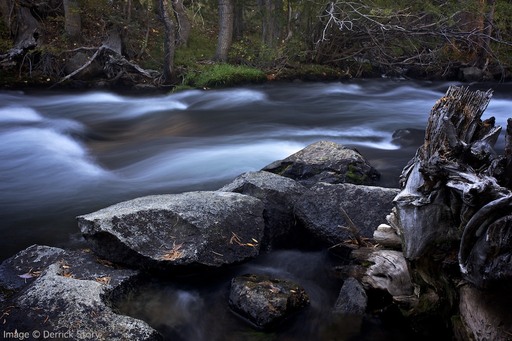Water is one of my favorite photo subjects, in part because there are so many things you can do with it. Recently I photographed a mountain stream in the Eastern Sierra of California. For this image, I wanted the water soft and dreamlike.
Start with the camera mounted on a tripod to steady the shot. I prefer exposures around 2 seconds. At that interval, the water is softened, but not overly dreamy. To create this long exposure, I put the camera in Aperture Priority mode and stop the aperture down to f/16. I then add a polarizer to give me another 2 stops of density. If I'm working in early morning light, this will usually provide the shutter speed I'm looking for. One important tip, make sure you're not in Auto ISO. Set the camera manually to its lowest ISO setting. Then use the self-timer or a remote release to take the shot. You don't want to jar the camera when making the exposure.
These images can be real eye-catchers when showing off your landscape work.
Find great deals at the TDS Photography Store on Amazon.
















Derrick, perfect timing! We will talk about shutter speed in my "Exposure" class next week and I will send everyone to read this post. Thanks.
I am in a photography class and i asked the teacher on how to create this effect. He is going to explain it to me tomorrow but luckily I am a step ahead. I will practice it. Thanks.
Hi Bill and Rosselyn, So glad to hear that my timing is good. It's such a fun technique...
Question - A polarizer typically reduces light by about 1.5 to 2.0 stops, but this will vary by both the angle of the sun and the "rotation setting" on the polarizer itself. If the greatest amount of polarization happens when the sun is 90 degress to the line of sight, how can we pull off 2 tops of light in early morning when the sun is nearly horizontal to the line of sight? Won't the polarizer be essentially useless as a pseudo ND filter in morning light? Not trying to question this tip. I've just never tried this technique and often wondered if a polarizer can truly be used as a pseudo ND filter in early morning or late evening light.
Hi Derrick,
Looks like your recent photos trip went well and you where able to get some great shots. Been following your posting here.
iPhone 4S updated:
Well, the new iPhone 4S arrived this morning and all was going just fine.
Had the iCloud ready to go with my iPad 2 and MacBook Pro.
Went through all the process of setting of the iPhone 4S which was easy.
The problem came as I predicted is the fact the AT&T server to activate this phone is having problems. Just like I had stated I feel the server is over loaded and unable to activate all of these phones that arrived today. Just a message came up on the phone and stated I would receive an email when the phone is activated. Oh well I new this was going to happen. Now I have to wait until I will be able to try this 8MP camera with the Photo Stream (Apple Aperture). Hopefully this problem will ease up and I will get activated.
Best,
Stu
Stu
Hi Andy, All you have to do is look through the polarizer filter to see that it is dense. So you get the effect of neutral density regardless of the position of the sun. if you want a polarizing effect too, well, that's a different matter :)
Thanks Derrick. I guess I was always assuming that the density was coming from the polarizing effect, and not the filter itself. Will definitely be trying it out!